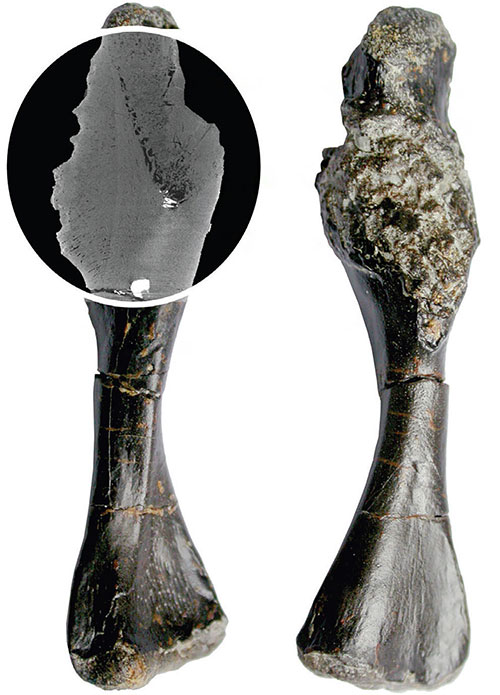When does the most terrible disease appear on Earth?
In 2001, in the Valley of the Kings of the Tuva Republic, Russian archaeologists discovered the tomb of a Scythian king dating to 2,600 years old, including more than 20kg of gold. But six years later, scientists discovered traces of a terrible disease on the man's body.

Bone turtle had cancer 240 million years ago.
For a long time, cancer was considered a modern disease, but, at the beginning of the 21st century, its trace was discovered in ancient Egyptian mummies, in Neanderthals and even on bones. of dinosaurs and animals A Synapsid side bow.
Considering everything, tumors come with multicellular life since it appears on the planet. Here is Sputnik's article about this content.
The disease of the Scythian king
In 2001, in the Valley of the Kings of the Tuva Republic, Russian archaeologists discovered the tomb of a Scythian king dating to 2,600 years old, including more than 20kg of gold.
Six years passed and the experts noticed the tiny dark spots covering almost the entire skeleton of a man. According to careful analysis results, these are metastatic traces - cancer cells separate from primary malignant tumors and form secondary drives of the disease in different parts of the body. That is, the king died of cancer. After comparing this data with modern cell samples, scientists discovered that it was prostate cancer.
Tumors with "life expectancy" of 1.7 million years old
Traces of malignant tumors and metastases were discovered in Egyptian mummies buried 2,250 years ago, in South American Inca remains, ancient Romans and medieval Britons.
In 2013, American paleontologists discovered a tumor on the ribs of a 120,000-year-old Neanderthal skeleton excavated near the village of Krapina in Croatia. According to scientists, tumors stem from a rare disease - fibrosis caused by disruption of the ACVR1 gene. That is, cancer is hereditary, and environmental pollution is not the main cause of the current spread of cancer, the authors note.

The leg bone Australopithecus sediba is affected by Osteosarcoma.
This group of British and African scientists also shared this view. In 2016, they found traces of cancer cells in fossils in Swartkrans cave in South Africa. This is a trace of cancer cells in the toes of ancient people about 1.7 million years old. This toe of Australopithecus sediba , one of the ancestors believed to be of Homo sapiens, lived about 1.7 million years ago. Scientists don't know what caused this creature to die, but, apparently, with bone tumors, the organism cannot move normally.
Diseases in the Mesozoic era
American paleontologists in the past few years have studied more than 10,000 dinosaur vertebrae of 700 specimens in museums, and found cancer traces in nearly 100 speculum dinosaurs. Long lived in Ky Phan Trang about 70 million years ago.
Traces of a malignant tumor have been detected on the bones of the 240-million-year-old turtle (Pappochelys rosinae). Its skeleton was discovered in an area in southern Germany once an ancient lake during the Early Triassic period.
During the scan, scientists confirmed that the turtle suffered from osteoarthritis arising from "riot" of adult bone-based stem cells. Today such tumors often affect young people - this is one of the most common types of bone cancer in humans and animals.
Paleontologists from Washington University in Seattle (USA) have found the oldest cancer. They conducted studies to find out how the teeth appeared in mammals. For example, studied the skull of a Synapsid - the one-eyed animal whose "teeth" lived 255 years ago. million years at the end of the Paleozoic period.
To find out how the teeth were attached to the skull, the researchers cut a jaw into small pieces and saw bone bubbles on the roots of the ancient dentin's dentin. These are benign tooth tissue tumors.
Such tumors often form in the gums and on human teeth, they are not painful, do not interfere with the function of normal functioning. However, their presence warns the risk of future malignant manifestations. Excluding that, tumors come with multicellular life since multicellular life appears on the planet, the authors conclude.
- Add a terrible disease to humans
- The process of formation and evolution of life on Earth
- Asteroids have a velocity 'terrible' about to cross the Earth at Christmas
- The source of the terrible disease in the occupied IS regions
- The terrible disease on ancient Egyptian mummies
- The terrible heat once swept the globe
- What happens if the wind stops blowing on Earth?
- What terrible disaster will happen if the Earth has 67 moons?
- The terrible flood cooled the earth
- What if tomorrow woke up, all the ice on Earth would have melted?
- 10 terrible disasters in human history
- The terrible disaster of space exploration
 13 causes of non-itchy rash
13 causes of non-itchy rash How the mouse with human ears changed the world?
How the mouse with human ears changed the world? The truth about 'fried rice syndrome!
The truth about 'fried rice syndrome! What is dental implant?
What is dental implant?